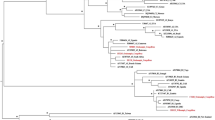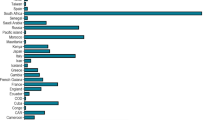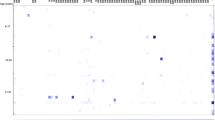Abstract
Infection with human herpesvirus 8 (HHV-8), the etiological agent of Kaposi's sarcoma, has been shown to display strong familial aggregation, in countries in which HHV-8 infection is endemic. We investigated 40 large families (608 subjects aged one to 88 years) living in an isolated area of Cameroon in which HHV-8 is highly endemic. We performed a two-step genetic analysis for HHV-8 infection status (HHV-8+/HHV-8− determined by immunofluorescence) consisting of an initial segregation analysis followed by a model-based genome-wide linkage analysis. Overall HHV-8 seroprevalence was 60%, increasing with age. Segregation analysis provided strong evidence for a recessive major gene conferring predisposition to HHV-8 infection. This gene is predicted to have a major effect during childhood, with almost all homozygous predisposed subjects (∼7% of the population) becoming infected by the age of 10. Linkage analysis was carried out on the 15 most informative families, corresponding to 205 genotyped subjects. A single region on chromosome 3p22 was significantly linked to HHV-8 infection (LOD score=3.83, P=2.0 × 10−5). This study provides the first evidence that HHV-8 infection in children in endemic areas has a strong genetic basis involving at least one recessive major locus on chromosome 3p22.
Similar content being viewed by others
Log in or create a free account to read this content
Gain free access to this article, as well as selected content from this journal and more on nature.com
or
References
Chang Y, Cesarman E, Pessin MS et al: Identification of herpesvirus-like DNA sequences in AIDS-associated Kaposi's sarcoma. Science 1994; 266: 1865–1869.
Gessain A, Briere J, Angelin-Duclos C et al: Human herpes virus 8 (Kaposi's sarcoma herpes virus) and malignant lymphoproliferations in France: a molecular study of 250 cases including two AIDS-associated body cavity based lymphomas. Leukemia 1997; 11: 266–272.
Gessain A, Sudaka A, Briere J et al: Kaposi sarcoma-associated herpes-like virus (human herpesvirus type 8) DNA sequences in multicentric Castleman's disease: is there any relevant association in non-human immunodeficiency virus-infected patients? Blood 1996; 87: 414–416.
Pica F, Volpi A : Transmission of human herpesvirus 8: an update. Curr Opin Infect Dis 2007; 20: 152–156.
Uldrick TS, Whitby D : Update on KSHV epidemiology, Kaposi Sarcoma pathogenesis, and treatment of Kaposi Sarcoma. Cancer Lett 2011; 305: 150–162.
Davidovici B, Karakis I, Bourboulia D et al: Seroepidemiology and molecular epidemiology of Kaposi's sarcoma-associated herpesvirus among Jewish population groups in Israel. J Natl Cancer Inst 2001; 93: 194–202.
Malope BI, Pfeiffer RM, Mbisa G et al: Transmission of Kaposi sarcoma-associated herpesvirus between mothers and children in a South African population. J Acquir Immune Defic Syndr 2007; 44: 351–355.
Mbulaiteye SM, Pfeiffer RM, Whitby D, Brubaker GR, Shao J, Biggar RJ : Human herpesvirus 8 infection within families in rural Tanzania. J Infect Dis 2003; 187: 1780–1785.
Plancoulaine S, Abel L, Tregouet D et al: Respective roles of serological status and blood specific antihuman herpesvirus 8 antibody levels in human herpesvirus 8 intrafamilial transmission in a highly endemic area. Cancer Res 2004; 64: 8782–8787.
Plancoulaine S, Abel L, van Beveren M et al: Human herpesvirus 8 transmission from mother to child and between siblings in an endemic population. Lancet 2000; 356: 1062–1065.
Bourboulia D, Whitby D, Boshoff C et al: Serologic evidence for mother-to-child transmission of Kaposi sarcoma-associated herpesvirus infection. JAMA 1998; 280: 31–32.
Plancoulaine S, Gessain A, van Beveren M, Tortevoye P, Abel L : Evidence for a recessive major gene predisposing to human herpesvirus 8 (HHV-8) infection in a population in which HHV-8 is endemic. J Infect Dis 2003; 187: 1944–1950.
Camcioglu Y, Picard C, Lacoste V et al: HHV-8-associated Kaposi sarcoma in a child with IFNgammaR1 deficiency. J Pediatr 2004; 144: 519–523.
Picard C, Mellouli F, Duprez R et al: Kaposi's sarcoma in a child with Wiskott-Aldrich syndrome. Eur J Pediatr 2006; 165: 453–457.
Sahin G, Palanduz A, Aydogan G et al: Classic Kaposi sarcoma in 3 unrelated Turkish children born to consanguineous kindreds. Pediatrics 2010; 125: e704–e708.
Byun M, Abhyankar A, Lelarge V et al: Whole-exome sequencing-based discovery of STIM1 deficiency in a child with fatal classic Kaposi sarcoma. J Exp Med 2010; 207: 2307–2312.
Picard C, McCarl CA, Papolos A et al: STIM1 mutation associated with a syndrome of immunodeficiency and autoimmunity. N Engl J Med 2009; 360: 1971–1980.
Brown EE, Fallin D, Ruczinski I et al: Associations of classic Kaposi sarcoma with common variants in genes that modulate host immunity. Cancer Epidemiol Biomarkers Prev 2006; 15: 926–934.
Masala MV, Carcassi C, Cottoni F, Mulargia M, Contu L, Cerimele D : Classic Kaposi's sarcoma in Sardinia: HLA positive and negative associations. Int J Dermatol 2005; 44: 743–745.
Brown EE, Fallin MD, Goedert JJ et al: Host immunogenetics and control of human herpesvirus-8 infection. J Infect Dis 2006; 193: 1054–1062.
Plancoulaine S, Abel L, van Beveren M, Gessain A : High titers of anti-human herpesvirus 8 antibodies in elderly males in an endemic population. J Natl Cancer Inst 2002; 94: 1333–1335.
Bonney GE : Regressive logistic models for familial disease and other binary traits. Biometrics 1986; 42: 611–625.
Plancoulaine S, Gessain A, Joubert M et al: Detection of a major gene predisposing to human T lymphotropic virus type I infection in children among an endemic population of African origin. J Infect Dis 2000; 182: 405–412.
Demenais F, Lathrop GM : REGRESS: A computer program including the regressive approach into the LINKAGE programs. Genet Epidemiol 1994; 11: 291.
Lathrop GM, Lalouel JM, Julier C, Ott J : Strategies for multilocus linkage analysis in humans. Proc Natl Acad Sci USA 1984; 81: 3443–3446.
Abecasis GR, Cherny SS, Cookson WO, Cardon LR : Merlin – rapid analysis of dense genetic maps using sparse gene flow trees. Nat Genet 2002; 30: 97–101.
Lander E, Kruglyak L : Genetic dissection of complex traits: guidelines for interpreting and reporting linkage results. Nat Genet 1995; 11: 241–247.
Dupuis J, Siegmund D : Statistical methods for mapping quantitative trait loci from a dense set of markers. Genetics 1999; 151: 373–386.
Alcais A, Quintana-Murci L, Thaler DS, Schurr E, Abel L, Casanova JL : Life-threatening infectious diseases of childhood: single-gene inborn errors of immunity? Ann NY Acad Sci 2010; 1214: 18–33.
Mira MT, Alcais A, Nguyen VT et al: Susceptibility to leprosy is associated with PARK2 and PACRG. Nature 2004; 427: 636–640.
Alcais A, Alter A, Antoni G et al: Stepwise replication identifies a low-producing lymphotoxin-alpha allele as a major risk factor for early-onset leprosy. Nat Genet 2007; 39: 517–522.
Cobat A, Gallant CJ, Simkin L et al: Two loci control tuberculin skin test reactivity in an area hyperendemic for tuberculosis. J Exp Med 2009; 206: 2583–2591.
Fujii K, Munshi UM, Ablan SD et al: Functional role of Alix in HIV-1 replication. Virology 2009; 391: 284–292.
Kato H, Horikoshi M, Roeder RG : Repression of HIV-1 transcription by a cellular protein. Science 1991; 251: 1476–1479.
Wang C, Gale Jr M, Keller BC et al: Identification of FBL2 as a geranylgeranylated cellular protein required for hepatitis C virus RNA replication. Mol Cell 2005; 18: 425–434.
Kisielow J, Nairn AC, Karjalainen K : TARPP, a novel protein that accompanies TCR gene rearrangement and thymocyte education. Eur J Immunol 2001; 31: 1141–1149.
Kim J, Lee J, Yadav N et al: Loss of CARM1 results in hypomethylation of thymocyte cyclic AMP-regulated phosphoprotein and deregulated early T cell development. J Biol Chem 2004; 279: 25339–25344.
Dai P, Jeong SY, Yu Y et al: Modulation of TLR signaling by multiple MyD88-interacting partners including leucine-rich repeat Fli-I-interacting proteins. J Immunol 2009; 182: 3450–3460.
Iellem A, Mariani M, Lang R et al: Unique chemotactic response profile and specific expression of chemokine receptors CCR4 and CCR8 by CD4(+)CD25(+) regulatory T cells. J Exp Med 2001; 194: 847–853.
Andrew DP, Ruffing N, Kim CH et al: C-C chemokine receptor 4 expression defines a major subset of circulating nonintestinal memory T cells of both Th1 and Th2 potential. J Immunol 2001; 166: 103–111.
Stine JT, Wood C, Hill M et al: KSHV-encoded CC chemokine vMIP-III is a CCR4 agonist, stimulates angiogenesis, and selectively chemoattracts TH2 cells. Blood 2000; 95: 1151–1157.
Moore PS, Boshoff C, Weiss RA, Chang Y : Molecular mimicry of human cytokine and cytokine response pathway genes by KSHV. Science 1996; 274: 1739–1744.
Witwer KW, Sisk JM, Gama L, Clements JE : MicroRNA regulation of IFN-beta protein expression: rapid and sensitive modulation of the innate immune response. J Immunol 2010; 184: 2369–2376.
Dessein AJ, Hillaire D, Elwali NE et al: Severe hepatic fibrosis in Schistosoma mansoni infection is controlled by a major locus that is closely linked to the interferon-gamma receptor gene. Am J Hum Genet 1999; 65: 709–721.
Marquet S, Abel L, Hillaire D et al: Genetic localization of a locus controlling the intensity of infection by Schistosoma mansoni on chromosome 5q31–q33. Nat Genet 1996; 14: 181–184.
Mira MT, Alcais A, Van Thuc N et al: Chromosome 6q25 is linked to susceptibility to leprosy in a Vietnamese population. Nat Genet 2003; 33: 412–415.
Siddiqui MR, Meisner S, Tosh K et al: A major susceptibility locus for leprosy in India maps to chromosome 10p13. Nat Genet 2001; 27: 439–441.
Baghdadi JE, Orlova M, Alter A et al: An autosomal dominant major gene confers predisposition to pulmonary tuberculosis in adults. J Exp Med 2006; 203: 1679–1684.
Plancoulaine S, Gessain A, Tortevoye P et al: A major susceptibility locus for HTLV-1 infection in childhood maps to chromosome 6q27. Hum Mol Genet 2006; 15: 3306–3312.
Acknowledgements
We thank the families from the Ntem valley for their participation in this study; Alain Froment, Philippe Tuppin, Edouard Betsem and Richard Njouom for assistance with data collection; and all members of the two branches of the Laboratory of Human Genetics of Infectious Diseases for fruitful discussions. This work was supported by INSERM, Institut Pasteur and Centre National de Génotypage, Centre National de la Recherche Scientifique (CNRS, Comité Environnement et Santé), Association pour la Recherche contre le Cancer (ARC), Programme National de Recherche Fondamentale en Microbiologie et Maladies Infectieuses et Parasitaires, Institut Pasteur (action concertée Inter-Pasteurienne for ‘HHV-8 and Kaposi's Sarcoma in intertropical countries’), the Rockefeller University Center for Clinical and Translational Science grant number 5UL1RR024143, The Rockefeller University and St Giles Foundation. SP received funding from Assistance-Publique–Hôpitaux de Paris. MB was supported by the Irvington Institute Fellowship Program of the Cancer Research Institute.
Author information
Authors and Affiliations
Corresponding authors
Ethics declarations
Competing interests
The authors declare no conflict of interest.
Additional information
Supplementary Information accompanies the paper on European Journal of Human Genetics website
Supplementary information
Rights and permissions
About this article
Cite this article
Pedergnana, V., Gessain, A., Tortevoye, P. et al. A major locus on chromosome 3p22 conferring predisposition to human herpesvirus 8 infection. Eur J Hum Genet 20, 690–695 (2012). https://doi.org/10.1038/ejhg.2011.260
Received:
Revised:
Accepted:
Published:
Issue date:
DOI: https://doi.org/10.1038/ejhg.2011.260



